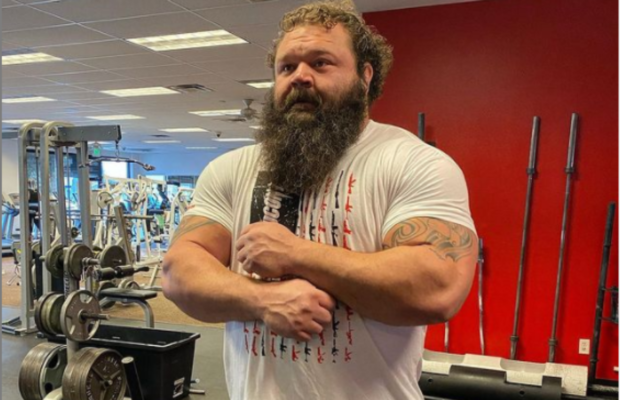Since Oberst is a professional strongman, he approaches the bench press as an accessory lift. Compared to a powerlifter, who trains to bench press in a competition, strongmen and strongwomen don’t perform bench presses for points. For strongman competitors, the bench press facilitates overall pressing strength, which then carries over to log presses and other movements.
As a result, Oberst doesn’t have as much of an arch in his back when bench pressing. During a powerlifting meet, it is not uncommon to see a competitor’s back arching so much that it appears as though only their hip bone and traps are touching the bench.
That is not to say that Oberst is making the mistake of going flat-backed on the bench when pressing. He does still have a slight arch in the lower back. It is just not nearly as pronounced as someone whose aim is to hit a one-rep max.
This is a popular channel for strongman news.
Bend the Bar
The first tip for a bigger bench is torque or “loading the spring” — a commonly used cue. To properly apply torque during a bench press, imagine “bending the bar” by turning the wrists inward. By doing so, the elbows will naturally tuck — preventing improper flaring — and the lats will naturally squeeze down and back (what is often referred to as “packing”). All of that together will put the body in a safer position that won’t leave the lifter as susceptible to possibly tearing a ligament or falling out of balance.
You want to put your body in a position where the easiest for your arms and chest is to push the weight away.
During the eccentric portion of the movement (lowering the bar), Oberst says proper torque will “bunch everything up nice and tight to push back out” like a “hydraulic pump.” Hence, the cue is “loading the spring.”
Article reprinted by permission. Read the original article in Barbend.com by Phil Blechman
Control the Weight
Oberst more or less defines control as training the muscle fibers responsible for keeping everything aligned and balanced throughout the movement. Not only is this important in terms of safety, posture, and time under tension, but it is also an important aspect of building strength and ensuring that one arm (usually dominant) takes on more of the load than the other. Additionally, it offers a more accurate idea of how heavy the lifter is truly capable of lifting.
How does one implement control? For Oberst, it means a slow and thoughtful eccentric movement before an explosive concentric movement.
That slow drop is why I’m strong.
Oberst attributes his ability to adapt and keep his form consistent during a heavier lift, regardless of whether he is having a “good day” or “bad day,” to applying control to accessory movements like this. Control during training is “thinking long term.”
Use Different Hand Positions
The final tip is “do the reps,” which Oberst further defines as “do the reps in lots of different positions.” Oberst advocates for performing “suicide sets” — sets that go nearly to failure — in one hand position and then changing to a different hand position. For example, he will start with a suicide set in a standard position, then perform a suicide set with a close grip, and then another suicide set with a wide grip.
The biggest benefit of position variance is to work muscles that are often neglected by only doing a conventional bench press in training. According to Oberst, it will better prepare you for competition and be more able to adapt when necessary.
Wrapping Up
Bending the bar (torque), control, and “doing the reps” are Oberst’s three tips for building a stronger bench press. As a mainstay of the WSM competition for nearly a decade, Oberst knows a thing or two about applying these techniques in the gym and translate their benefits to the competitive stage. Hopefully, these tips apply to your training as well, so you, too, can build a bigger bench press.
Featured image: @robertoberst on Instagram
About BarBend
BarBend covers a wide range of topics in strength, including training, nutrition, sports, news, analysis, reviews, and opinion. Whether you’re a seasoned lifter, new to the gym, or a dedicated strength sports fan, we’re your go-to source for the content you need to know!
Our team of in-house editors has decades of combined experience in strength training content. The majority of reviews on our site are written based on their first-person experience and testing. We also feature content from dozens of top contributing writers, coaches, and athletes from around the world. And BarBend’s Expert Network features medical professionals, trainers, and researchers who help verify the accuracy of our content, specifically select training and reviews topics. Content that is Expert Verified is indicated at the top of each corresponding article. We also work to keep our content up-to-date and indicate the day of the most recent editorial updates at the top of our articles.
BarBend is also the Official Media Partner of USA Weightlifting, the governing body for the sport in the United States.
